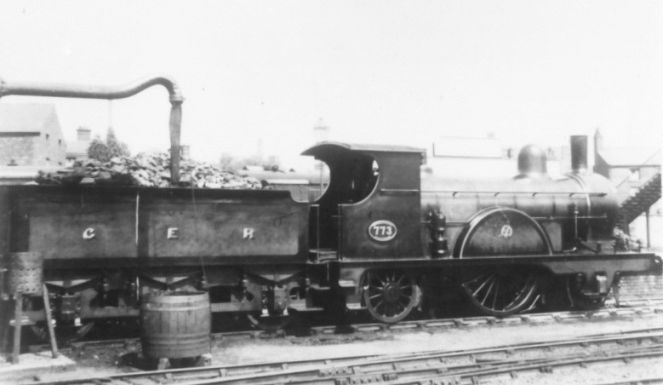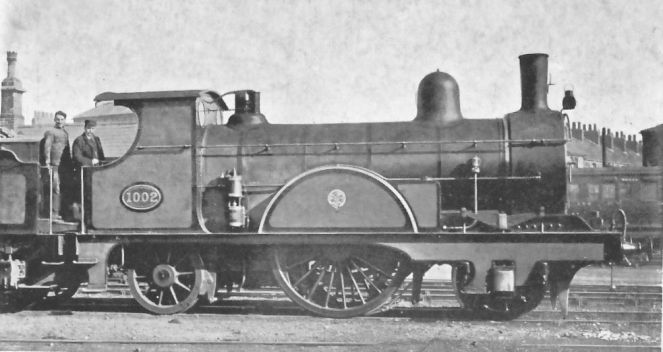D27 Class 2-2-2 1888-1893
789, 770-779, 1000-1009
 GERS Collection 7026/385
GERS Collection 7026/385
In the 1890s the principal fast express passenger trains were generally still light-weight, and many locomotive engineers still preferred the ‘single driver’ for its free-running characteristics. James Holden had previously been Principal Assistant to William Dean on the Great Western Railway, and so was well-used to his old chief’s 2-2-2s and 4-2-2s. Not un-naturally perhaps, one or two T19 2-4-0s were experimented with by removing the coupling rods, and tried on the lighter GER expresses, with success. In February 1889 Holden turned out a new purpose-built 2-2-2 numbered 789. It was identical to the contemporary T19 2-4-0s except that it had an inside-bearing carrying axle in place of the trailing coupled axle. Thus it had a 140 lb. level grate boiler made in three rings with the dome on the middle, and the earlier form of Westinghouse brake cylinders placed between the brake levers, applying the brakes to the rear of the driving wheels and to the front of the trailing wheels. However, it differed from the T19s in one important detail, in that it had india-rubber pads to the spring hangers. It is probably because of this feature that Holden managed to get the engine built, for it was constructed to “Locomotive Machinery” order No. LM68, instead of the usual “Letter Account”. No new tender was built for it, and it was coupled to one of the 2612-gallon tenders from a recently-scrapped Adams ‘Mogul’. Incidentally, several authors had claimed that the engine originally bore the number 740 – the next-available number in the T19 series – but was later altered to 789. However, all surviving records show that it was intended to number it 789 from the beginning. The engine proved successful, and india-rubber spring pads were adopted as a standard feature on most subsequent GER locomotive classes. Over two years later, a batch of ten of the 2-2-2s were built to “Letter Account” D27 in the normal manner, and this then became the class designation. The ten new engines were built in June and July 1891 as 770-779, and were again identical to the contemporary T19s 760-769 (q.v.), having the later two-ring sloping grate boiler, equalised brake rigging, the improved cylinder design, and spring rubbers. They also had large sand-boxes allied to the splashers, rather than beneath the footplating, and were fitted with new S23 class 2640 gallon tenders. No 773 of the ‘production batch’ is shown in the photograph.

LPC 396/GERSHC 7005/088
A final batch of ten D27 2-2-2s was built in 1893. Again similar to the contemporary T19s, they had their boilers pressed to 160 lbs. psi, flanged smokeboxes from new, and the final pattern of leading axle-guards with a ‘scalloped’ trailing edge. No. 1002 is seen in the photograph. In 1895 consideration was given to running the ‘Cromer Express’ non-stop from Liverpool Street, utilising the water troughs that were being installed on the route. A test run with D27 No. 1006 was made in the November, the locomotive being temporarily coupled to a larger H14 class 3066 gallon tender to provide sufficient water. It was intended to inaugurate the new train with the commencement of the summer timetable in 1896, and so six of this final batch of engines – 1004-1009 – had water scoops fitted to their tenders, and in addition they were converted to oil burning. Eleven of the class were given new boilers in 1899-1902, but by this time the D27s were out-classed on the express trains, and they were withdrawn between 1901 and 1907. The D27s provided the only instance in which it was possible to compare the performance of the 2-2-2 and 2-4-0 wheel arrangements with all other factors being identical. This the renowned locomotive performance recorder Charles Rous-Marten did, and came to the contrary conclusion that the ‘singles’ were better at getting away, whilst the 2-4-0s were faster and freer-running!
